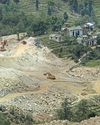Yongchak is a Manipuri legume used in salads, pickles and delicacies

GROWING YONGCHAK is excellent business today. A tree can provide an income of about R1.5 lakh in a season. A family that has a few trees need not do anything else for a living,” says Jeena Sorokhaibam, founder of Lookacteast Kitchen, a Delhi-based eatery that specialises in Manipuri cuisine. Four to five pods sell for R100 in Manipur and a tree produces more than 15,000 pods in a season.
Also called bitter beans, twisted cluster beans and stink beans because of its peculiar smell, yongchak is a semi-wild species that grows in the backyard and concerted attempts to cultivate it have not happened. Yongchak flowers and beans are part of many delicacies, but it is the pods that are most commonly eaten.
“Yongchak pods are available from October to March. This is when the beans inside are just developing and the pods are tender enough to be eaten raw as crunchy salad, or shingju. By March, the pods are mature and have prominent black-coloured beans inside. These are removed and dried to be eaten during the rest of the year. Whole yongchak is also dried and stored,” she says.
This story is from the March 16, 2019 edition of Down To Earth.
Start your 7-day Magzter GOLD free trial to access thousands of curated premium stories, and 9,000+ magazines and newspapers.
Already a subscriber ? Sign In
This story is from the March 16, 2019 edition of Down To Earth.
Start your 7-day Magzter GOLD free trial to access thousands of curated premium stories, and 9,000+ magazines and newspapers.
Already a subscriber? Sign In

A JOKE, INDEED
A CONFERENCE OF IRRESPONSIBLE PARTIES THAT CREATED AN OPTICAL ILLUSION TO THE REALITY OF A NEW CLIMATE

THINGS FALL APART
THE WORLD HAS MADE PROGRESS IN MITIGATING EMISSIONS AND ADAPTING TO CLIMATE IMPACTS. BUT THE PROGRESS REMAINS GROSSLY INADEQUATE

VAPOUR ACTION
MOISTURE IS A SILENT FORCE THAT AMPLIFIES GLOBAL WARMING. YET SCIENTISTS UNDERSTAND LITTLE ABOUT THIS GREENHOUSE GAS AND HOW IT INFLUENCES WEATHER SYSTEMS

OPEN AND SHUT CASE
2024 WITNESSED A RECORD NUMBER OF ATTRIBUTION STUDIES THAT SHOW CLIMATE CHANGE AS THE KEY FACTOR BEHIND EXTREME WEATHER EVENTS

TEST OF SURVIVAL
GENERATION ALPHA INHERITS A WORLD IRREVOCABLY WARMER BY 1.5°C

THE YEAR PLANET CHANGED
WE KNOW THAT WE LIVE IN THE AGE OF CLIMATE EXTREMES. WE ARE NOT IN DENIAL. BUT WE ARE NO LONGER THE SOCIETIES THAT WORK FOR COMMON CAUSES

A SPRIG TO CARE FOR
Punarnava, a perennial herb, is easy to grow and has huge health benefits

DIGGING A DISASTER
Soapstone mining near Dabti Vijaypur village has caused many residents to migrate.

REVIEW THE TREATMENT
Several faecal sludge treatment plants in Uttar Pradesh suffer from design flaws that make the treatment process both expensive and inefficient

MAKE STEEL SUSTAINABLE
As India works to double its GDP by 2030, its steel industry must balance growth with sustainability. By embracing policies like the Steel Scrap Recycling Policy 2019 and adopting green technologies, India is paving the way for a more sustainable future in steel production